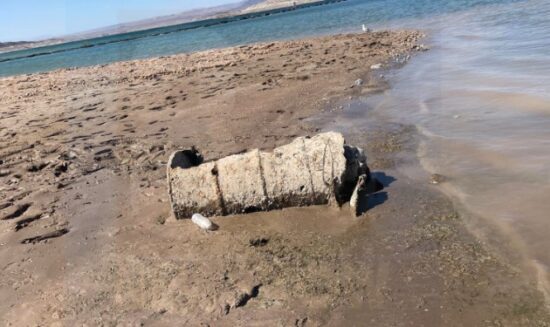I’m a huge fan of Michael Connelly’s Hieronymous (Harry) Bosch. His detective stories take place often with commutes between Los Angeles and Las Vegas. And the current climate conditions have at times formed parts of the narrative. But I thought of Harry Bosch as I read the story about boaters who set out on Lake Mead last Sunday only to come across a rusty metal barrel stuck in the mud that emerged as the lake’s water level continues to drop. Inside the barrel were human remains. A whodunit cold case for a detective like Harry Bosch.
A megadrought has made conditions in the Southwestern United States drier than at any time in the last 1,200 years. The Colorado River watershed has been most affected. It serves the Southwest two ways: hydroelectric power, and freshwater for farms and the communities within and beyond the river’s reach. Las Vegas, Phoenix, and Los Angeles depend on Colorado River water coming from Lake Mead. Three years ago, the U.S. Bureau of Land Reclamation declared the river had reached a climate tipping point and suggested farmers pull up stakes and give back their water usage rights.
This week, California declared a water conservation emergency with Lake Mead waters continuing to decline. CNN reported that the Southern Nevada Water Authority no longer could draw water from the intake valves on the Lake. These were first installed in the 1970s. Now a new emergency valve installed much deeper in the Lake is being used to deliver water to Las Vegas, a city of 2.4 million.
The U.S. Drought Monitor recently declared the Colorado River to be in a state of extreme and exceptional drought. It has lasted more than twenty years and is only getting worse. Officials this week told Southern Californians to limit outdoor water use to once per week, a first for the region. A spokesperson for the Metropolitan Water District of Southern California told CNN there is not enough for the six million who rely on Lake Mead as their primary freshwater source.
But who would have thought the drought, exacerbated by global warming from climate change, would turn up a body stuffed in a rusty barrel? A homicide detective from the City of Las Vegas stated that the victim was killed sometime in the 1980s based on contents found with the corpse. He further told KLAS news to expect more bodies to emerge as Lake Mead levels continue to decline. Who would have thought that the intersection of climate change and Las Vegas’ criminal past would make headlines?
Crime and Las Vegas go back to the city’s founding. Bugsy Siegel, a mobster originally from New York, first convinced his associates at Murder Inc. to finance his resort, El Rancho Vegas, which was built in the middle of the Nevada desert where there was very little of anything. Today the site of El Rancho is at the heart of the Las Vegas Strip.
Back in the 1980s at the time of the dumping, the barrel would have settled into water several metres deep. But the water levels last week dropped to 321.8 metres (1,056 feet), more than 50 metres (more than 160 feet) below Lake Mead’s normal surface elevation and well below levels in the 1980s.
The emergence of a murder victim in Lake Mead gives the term aridification, the one climatologists use to describe what is being observed in the U.S. Southwest, a whole new meaning. Aridification is now helping detectives like Harry Bosch to find missing bodies from cold cases going back decades as they emerge from their hiding beneath the waters of a lake succumbing to climate change.









